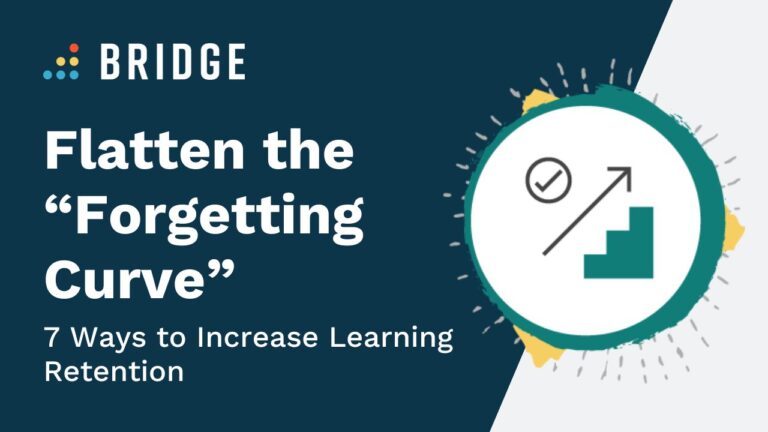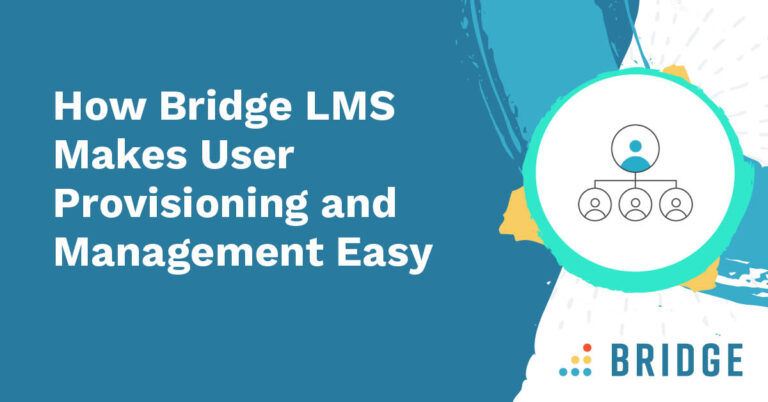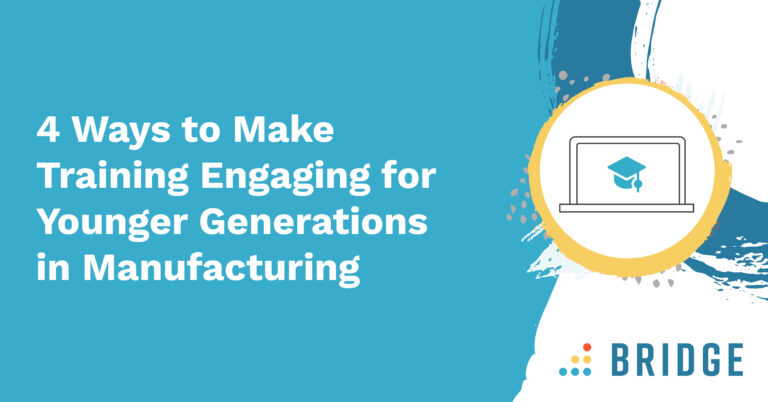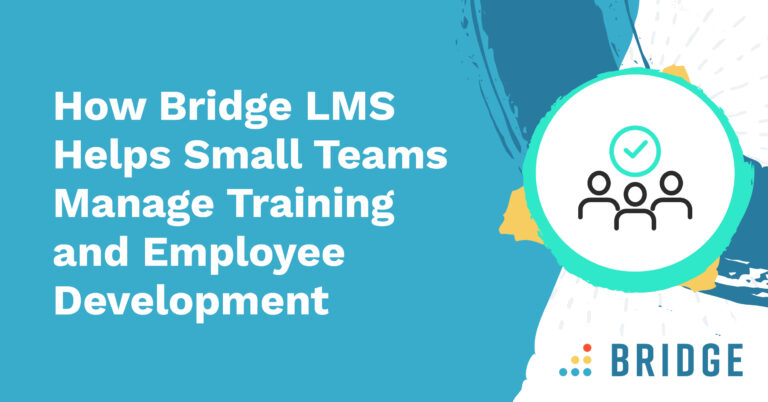With skills gaps widening and organizations trying to achieve continual growh targets it’s essential to invest in learning and development opportunities for your current workforce.
LinkedIn’s Workplace Learning report findings show that L&D budgets remain robust, and 50% of C-Suite execs are more involved in decisions about training investments.
However, for this increased investment to translate into better outcomes, development strategies must account for learners’ needs and create courses that facilitate long-term retention and application of skills.
How Do We Learn and Retain Information?
Finding ways to help learners engage with training is only half the story—making that learning stick and ensuring they retain and use training over time is the important second step.
It’s human nature to forget. In fact, 19th-century psychologist Ebbinghaus first studied the rate of forgetting and found that memory loss follows a specific pattern: The rate at which we forget newly-acquired information—“the forgetting curve”—shows that we begin to forget new information immediately, and over time, we forget more and more.
The only way to minimize the loss of knowledge is to regularly revisit and refresh information—especially within the first 30 days of acquiring a piece of knowledge.
LAUNCH SUCCESSFUL L&D PROGRAMS WITH THESE BEST PRACTICES | ‘How to Launch a Training Program at Your Organization [The Ultimate Guide]’
7 Ways to Get Ahead of the Forgetting Curve and Make Learning Stick
Here are seven ways to combat the forgetting curve and increase learning retention by delivering information at opportune moments and strengthening concepts through practice and feedback:
1) Space Training Out Over Time
If learners feel overwhelmed and inundated, there’s a good chance they won’t absorb or retain new information. Combat overload by gradually building upon ideas and reinforcing knowledge retention through ongoing repetition and practice. Research shows a clear link between spaced repetition and increased learning retention—by learning over multiple sessions and repeating key information, people can recall up to 5x more information.
Courses and programs should test small bits of knowledge to help learners cement an understanding of specific details. It’s also an effective way to give your people action points and next steps that they can carry forward and apply as they progress through programs.
Look for a learning platform with comprehensive analytics to see how people use and apply their training and where they could benefit from a refresher. If it’s been a while since users last logged in, nudges, deadlines, and reminders can set learners back on track.
Information should also be easy for learners to dip into at their own pace and to find the answers they’re looking for in their moment of need. Quizzes, tests, and simulations can promote retention through practice and repetition.
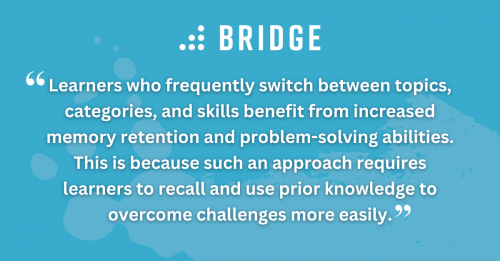
MORE WAYS TO GET THE MOST OUT OF YOUR LEARNING STRATEGY | ‘Build or Buy: 6 Questions to Enhance Your Learning and Development Strategy’
2) Adopt a Blended Learning Approach
Repetition is key to knowledge retention. However, that doesn’t necessarily mean that continuously drip-feeding learners the same information in the same way will be effective. Keep material relevant and enjoyable with a varied approach to format and style to aid memory retention.
Findings from a study at the University of California show that learners who frequently switch between topics, categories, and skills benefit from increased memory retention and problem-solving abilities. This is because such an approach requires learners to recall and use prior knowledge to overcome challenges more easily.
Your learners should have the chance to use the theoretical knowledge they’ve gained, formalizing it through real-world experiences and practical application. By exposing them to a wide range of scenarios and contexts in which they’re likely to encounter and build transferable skills, you keep training engaging, reinforcing concepts and ideas with practice, resulting in better memory recall.
CREATE CONTENT THAT RESONATES | ‘Does Your L&D Approach Meet the Needs of Today’s Learner?’
3) Personalize the Learning Experience
Every learner deserves a unique learning experience crafted around their career goals and development needs. Personalized learning pathways support people in achieving their goals by tailoring training to their interests and needs.
Your people want to learn new skills. According to research conducted by Oracle, 85% of employees are ready to develop and want employers to provide more impactful L&D opportunities. In addition, 82% believe that technology can best support their career development. Identifying and delivering training opportunities that resonate boosts motivation and keeps your people on track and focused toward goals.
Automating and scheduling training ahead of time, assigning deadlines, and setting a regular cadence for performance conversations can encourage a habit of continuous learning, resulting in closer goal alignment and better results. When employees are developing the skills that advance their careers, and have personalized development plans, they know what’s expected of them and how to accomplish their goals.
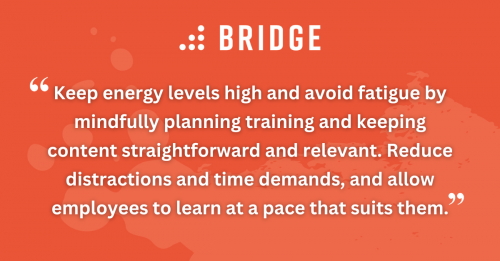
LOOKING FOR MORE WAYS TO INCREASE LEARNING RETENTION? | ‘10 Facts & Stats About Learning Retention You’ll Want to Remember’
4) Give Learners Time to Practice and Reflect on Training
Employees need dedicated time to focus on learning, reflect on lessons, and practice skills in a safe environment. Gartner research shows that there’s no correlation between productivity and hours spent working. Rather, when rest is a proactive part of the workflow, employee performance is 26% higher.
Keep energy levels high and avoid fatigue by mindfully planning training and keeping content straightforward and relevant. Reduce distractions and time demands, and allow employees to learn at a pace that suits them.
Break complex topics down, giving your learners plenty of time and space to process and practice what they learn. Controlling the flow of information and spacing training over longer stretches of time makes for a manageable experience where people can learn, reflect, and build upon their skills with confidence. Ensure learners can only progress with training once they’ve had a chance to review material and understand what they’ve learned. Less is more, so always keep content simple!
TOP TIPS TO HELP LEARNERS MAKE TIME FOR TRAINING | ‘Your Employees Are Busy—Here’s How to Offer Protected Learning Time’
5) Open Channels of Communication With Peer Learning Opportunities
Make training a shared, collaborative experience through peer learning, group projects, and live training sessions. A Cambridge University study shows that in a remote learning environment, social collaboration and group learning can improve memory recall among peers.
Activities that spark discussion, promote problem-solving, role play, and the application of knowledge and skills makes the learning experience engaging and memorable. Your learning platform can facilitate connection, active participation, and real-time interaction.
Integrating small initiatives like group chats into the workspace can foster a sense of community among your learners, leading to increased teamwork and better knowledge retention. This is a simple and powerful way for people to learn from each other and reinforce their understanding by teaching others.
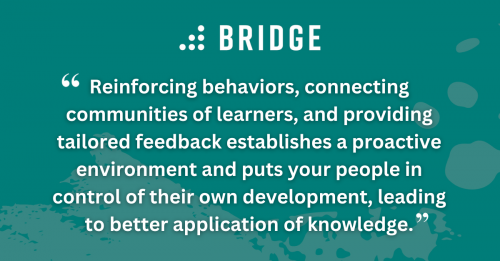
MORE WAYS TO KEEP YOUR LEARNERS CONNECTED | ‘5 Great Ways to Encourage Social Learning In the Workplace’
6) Deliver Learning in Bite-Sized Microlearning Pieces
Microlearning compensates for short attention spans and conflicting schedules. Boiling information down to the basics and delivering it in accessible formats that take less than ten minutes to complete gives learners the information they need in a context that allows them to use and apply training immediately.
The results from a study of post-graduate learners backs this idea up. Instead of overloading people with too much information in one sitting, complex subject matter was broken down and learned in short, focused bursts consisting of:
- Distilled content
- Peer teaching
- Multiple short courses
As a result, those who worked at a manageable and controlled pace and learned a little at a time were more likely to recall and incorporate the information they’d learned.
On-demand and accessible resources available across multiple devices give people greater control over their learning experience, expanding their knowledge with easy-to-access training.
Your learning platform should offer easy access to training with personalized recommendations and easy searching and sharing functionalities. When resources are readily available to learners in a range of engaging, informal, and action-based formats such as multiple-choice quizzes and short videos, you build and solidify knowledge with information that’s relevant to their needs.
MORE TO EXPLORE | ‘Beating Burnout: Why Microlearning Is a Must for Time-Poor Teams’
7) Provide Regular Skills Feedback
Learners need relevant and effective feedback that they can recollect and use to improve and grow. When that feedback is connected to demonstrated behaviors and competencies, you create more effective learning outcomes.
An environment with clarity around goals provides a structure for people to learn, review, and practice regularly, and 54% of employees feel that feedback is critical to improving their performance, according to Gartner research. In addition, employee performance can increase by 25%, and the likelihood of becoming high performers triples when managers embed the following processes into their teams’ workflow:
- They take the time to understand each employee as an individual and adapt their feedback style based on their unique strengths and needs
- They create an environment based on trust that empowers employees to share, learn from peers, and adopt the role of coaches
- They provide targeted feedback and encourage employees to connect to others who are best suited to provide coaching and feedback on needed skills
A tailored and proactive approach to employee development maximizes chances of success and allows you to track how they’re progressing toward goals and applying knowledge, while identifying and responding to skills gaps as they arise.
Involve people in the learning process with regular career conversations, skills feedback, and one-on-ones. Reinforcing behaviors, connecting communities of learners, and providing tailored feedback establishes a proactive environment and puts your people in control of their own development, leading to better application of knowledge.
DISCOVER HOW TO IMPROVE L&D OUTCOMES | ‘What Are SMARTER Goals and How Do They Help Measure Employee Productivity?’
Use Bridge LMS to Deliver Training Programs That Stick
Craft learning experiences your people will remember with Bridge LMS. Deliver personalized training programs that resonate, develop your people, and measure how effectively learners retain and apply knowledge and skills.
Increase learning retention, create a culture of learning and knowledge sharing, and help your people achieve their goals to maximize growth and get the best results.
